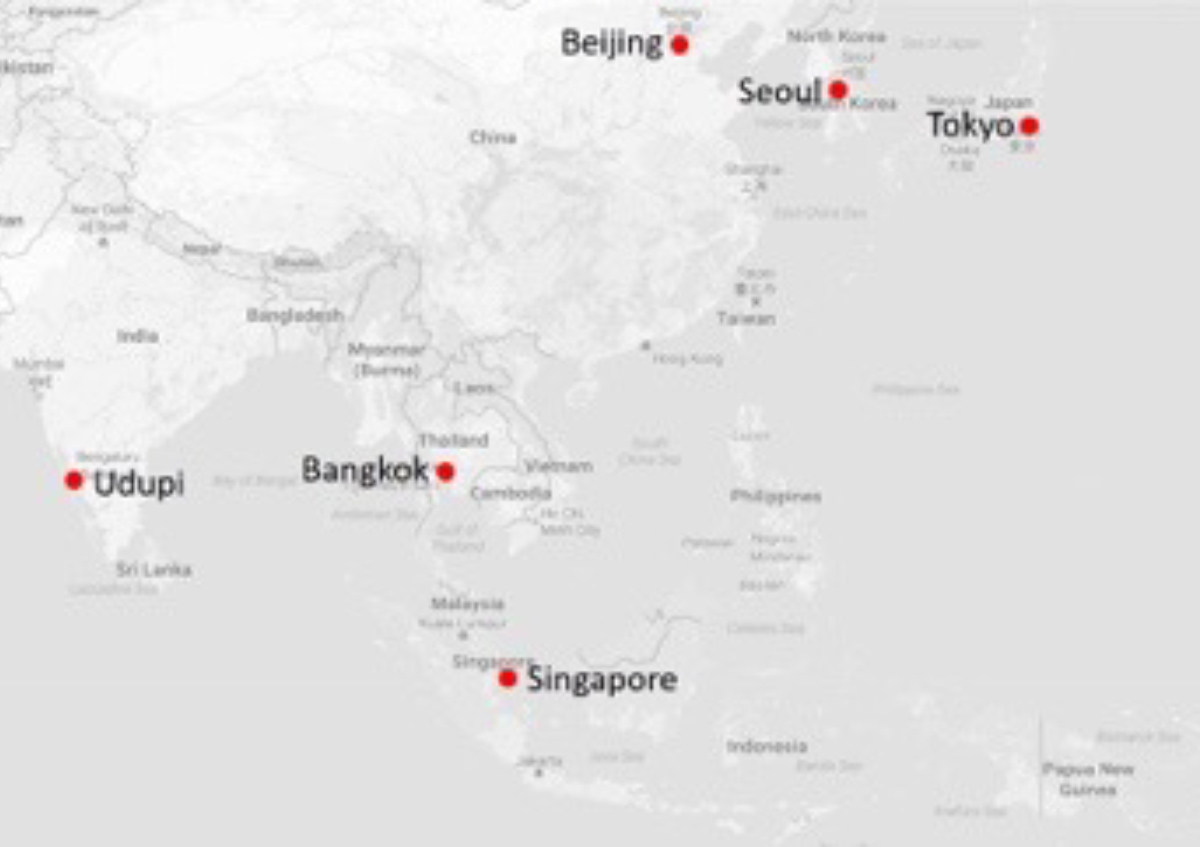
2030 Asia Nightscape Proposal
In the “Asian City Nightscapes / Now and Future Student Workshop Survey and Proposal” which was streamed at the pre-event, students from six Asian cities (Udupi (India), Singapore, Bangkok, Beijing, Seoul, and Tokyo) summarized their research and analysis of the nightscape of their cities and prepared proposals for what they would like their future cities to look like, either in 2030 or 2050. Polls were taken remotely from audience to choose which proposal they liked the best, a unique feature that was achieved with the online session.
First, the Udupi (India) team presented a unique storyline in which three heroes emerged in 2050 to save three cities in anticipation of natural disasters and conflicts that will occur after the COVID-19 pandemic. For urban city of Manipal, illumination of transportation terminal with bio-lighting, signage, and passage signage was proposed. For Udupi, a city with many historical buildings, cultural preservation and educational promotion through warm, flying smart lighting system and interactive façade lighting was proposed. In Malpe, a coastal area under threat of rising sea levels and other natural disasters, preservation of the marine environment and creation of new tourism resources through underwater walkways and hologram shows of marine life was proposed.

The Singapore team gave their report on their surveys and proposals for three local districts. In the residential area of Tiong Bahru, lighting system that would create a warm atmosphere and make the public spaces more comfortable was proposed. For the Chinatown Historic District, the team proposed a lighting design that respects cultural heritage and religion. For Orchard Street in the commercial area, lighting performance of various scales, the use of Li-Fi, an optical telecommunication technology that is said to surpass Wi-Fi in the future, and lighting events for pedestrian areas were proposed.

From the Bangkok team, a lighting scheme was proposed for the Kadijeen district, where there are Islamic temples. The scheme applies laser lighting and soft ambient lights floating on water to solve the problem of temples and riverfront areas being dark and inaccessible at night, and circular lighting system to illuminate the prayer space in front of the temple. In the Charoenkrung area, known for its thriving art scene, the team suggested improving safety by lighting up the access road from the pier and illuminating the mural art.

The fourth team, from Beijing, came up with proposals such as creating a public restroom with glowing walls that illuminate the town like a lantern, and a lighting scheme that utilizes AI to adjust color temperature so that office workers can relax at night. There were also other unique proposals for mobility spaces, such as lighting proposals for car interiors or vehicle lanes where automated and conventional vehicles are mixed, as well as lighting for terminal stations and a lighting system using drones.

The fifth team from Seoul predicted the future of Seoul by narrating a storyline in which people are migrating to the outskirts of the densely populated Seoul after the COVID-19 pandemic. Focusing on the changes of boundaries of administrative districts, the loss of public areas, and the outrun of artificial lighting over natural lights, the team envisioned a worst-case scenario in which the pandemic would not be over until 2050 and concluded their proposal with the hope that lighting will help people heal and keep connection between dispersed people even under the worst-case scenario.

Lastly, the Tokyo team focused on street lighting. Streetlights and security lights that uniformly illuminate a wide area for safety reasons are not comfortable to some people. As a solution, the team proposed a circular light emitting from bicycle tires—a method to make lighting smaller, more dispersed, and more operable. In addition, a light-emitting road surface was proposed instead of light being cast from the above. Providing bike share stations in easily accessible locations, not behind buildings, was another idea proposed, to be a place for people to relax as well as to serve as extension of streetlights.

After the session, votes were submitted from 62 viewers, and the proposal from Udupi (India) was selected as the first-place winner.
